Opal is the October birthstone – and its play-of-color is so mesmerizing that it borders on magical. From coveted black opal, to serene water opal, to blazing fire opal, there’s one for every taste. We help you find your favorite. (more…)
Opal is the October birthstone – and its play-of-color is so mesmerizing that it borders on magical. From coveted black opal, to serene water opal, to blazing fire opal, there’s one for every taste. We help you find your favorite. (more…)
Coveted for millennia, the June birthstone still reigns supreme as the queen of modern fashion. Elegant, stylish and organic, pearls come in a rainbow of colors and a range of shapes. Our pearl primer will help you choose beautiful ones.
In this post, we cover:
What Is a Pearl?
Akoya, Tahitian, South Sea and Freshwater Cultured Pearls
Pearl History and Lore
Where Pearls Come From
Pearl Qualities to Look For
Pearl Care and Cleaning

Faceted pearls are not your traditional cultured pearls. These avant-garde beauties can have 200+ facets on their surface. Photo: Robert Weldon/GIA. Courtesy: Victor Tuzlukov
June Birthstone: What Is a Pearl?
A pearl is an organic gem that grows inside saltwater and freshwater mollusks. These soft-bodied animals possess one (univalve) or two (bivalve) shells. Mollusks are invertebrates, meaning they lack a spine or vertebrae.
Gemologists divide the June birthstone into two categories:

Natural pearls are the focal point in this necklace from the Edwardian era. Photo: Robert Weldon/GIA
Cultured Pearls: Akoya, Tahitian, South Sea and Freshwater
Scientists estimate there are more than 100,000 different species of mollusks in the world’s waters. However, only a few dozen of these species produce the June birthstone and only about half of them are used to produce cultured pearls. Cultured pearls are classified by the species of mollusks that produce them.
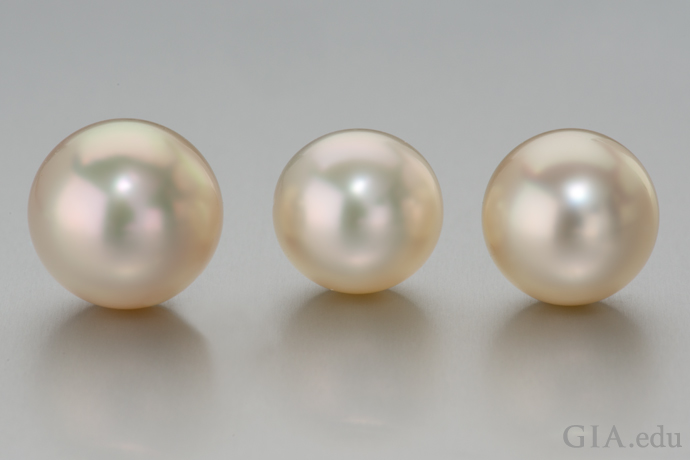
Akoya cultured pearls have an undeniable elegance. Photo: Robert Weldon/GIA
Akoya Cultured Pearls: The saltwater Pinctada fucata oyster produces white and cream-colored cultured pearls, generally between 2 and 11 mm in diameter, with the average being 6 to 8 mm. Akoya cultured pearls are often perfectly round and have a high luster (the light reflected from or near the pearl’s surface). Most akoya cultured pearls are commercially produced in Japan and China.

The many different colors of Tahitian cultured pearls are on display in this exceptional necklace, which features 27 cultured pearls that range from 13 to 19 mm. Photo: Robert Weldon/GIA. Courtesy: A Private Collector and Mona Lee Nesseth, Custom Estate Jewels
Tahitian Cultured Pearls: Famous for their exotic, almost luminescent colors, these are the product of the saltwater Pinctada margaritifera oyster, which is native to the islands of French Polynesia. The mollusk produces pearls in bodycolors sometimes described in the trade with names like aubergine (dark grayish purple), pistachio (yellowish green to greenish yellow), or peacock (dark green-gray to blue-gray, with pink to purple overtones). Tahitian cultured pearls generally range from 9 to 14 mm in diameter, most commonly 9 to 11 mm.

This necklace of semi-round South Sea cultured pearls with blue sapphire accents makes a breathtaking statement. Photo: Robert Weldon/GIA. Courtesy: Atelier Marisa
South Sea Cultured Pearls: The Pinctada maxima oyster is the largest of all saltwater cultured pearl oysters, and it can produce pearls from 8 to 20 mm in diameter; the average is 13 mm. There are two types of Pinctada maxima oysters: silver-lipped and gold-lipped. The silver-lipped oyster produces pearls that are mostly white to silver, sometimes with pink, blue or green overtones. The gold-lipped oyster produces mostly yellow to orangy yellow pearls, called “gold” or “golden” in the trade.
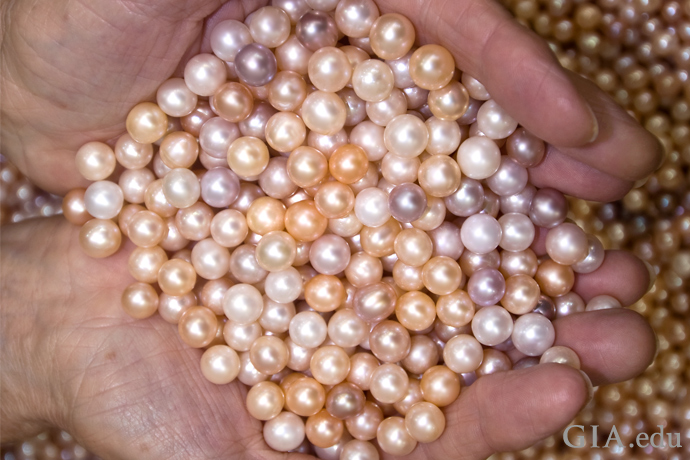
Pearls come in many colors, like these freshwater cultured pearls from China. Photo: Robert Weldon/GIA
Freshwater Cultured Pearls: From the mussel Hyriopsis cumingii or a hybrid, these pearls are produced primarily in the lakes, ponds and rivers of China. They come in many shapes, sizes (up to about 20 mm) and natural colors, including white, orange, lavender and purple. They are also dyed in a wide array of colors.
Gemologists love the June birthstone because of its luster – the reflection of light off its surface, and from concentric layers of nacre, like light bouncing off a convex mirror. Pearl’s texture also fascinates: Natural and cultured pearls have a slightly rough feeling when rubbed against your teeth, while imitation pearls are smooth. However, gemologists use X-rays to examine a pearl’s inner structure, which allows them to conclusively separate natural from cultured pearls.
June Birthstone: Pearl History and Lore
The origin of pearls fascinated our forebearers. Ancients from the Middle East believed that pearls were teardrops fallen from heaven. The Chinese fancied that the June birthstone came from the brain of a dragon. Christopher Columbus and his contemporaries thought that mollusks formed pearls from dew drops.
Pearls have long been associated with purity, humility and innocence. So it may be said that the June birthstone meaning is “sweet simplicity.” As such, pearls were traditionally given as a wedding gift.
The June birthstone was also thought to have beneficial properties. In the ancient Sanskrit text, the Atharvaveda, pearls were said to bestow long life and prosperity. In Asia, pearls were believed to help alleviate indigestion and hemorrhages. Arab physicians in the 1820s maintained that pearl powder improved eyesight, quieted nervous tremors and eased depression.
One of the most famous natural pearls is the 50.56 carat (ct) La Peregrina. About the size of a pigeon’s egg, the pearl was discovered in the 1500s in the Gulf of Panama. It became a prized possession of European royalty. Richard Burton eventually gifted it to Elizabeth Taylor in 1969; Christie’s New York auctioned it in 2011 for $11.8 million.
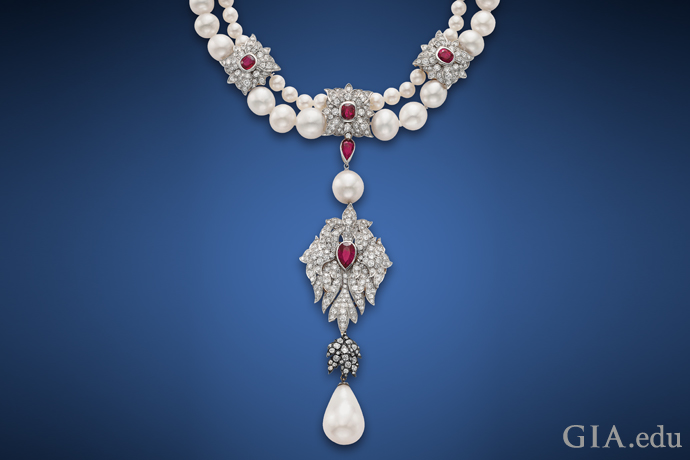
Literally a royal gem, Elizabeth Taylor’s 50.56 ct La Peregrina pearl was owned by eight Spanish kings, from Philip II (1582-1598) to Carlos IV (1778-1808). Cartier set the pearl as part of the pendant in this two-strand necklace that has 56 saltwater natural pearls, four cultured pearls, rubies and diamonds. Courtesy: Christie’s
June Birthstone: Where Pearls Come From
You’ll have to set sail for pristine waters if you want to find the June birthstone. Pearl-bearing mollusks fail to thrive in polluted waters, so pearl farms are usually located far from civilization – and often in breathtaking settings.
Saltwater pearls are grown in many areas around the world. Akoya cultured pearl farms are primarily found in Japan and China, especially along the southern coasts of Guangdong and Guangxi provinces. South Sea cultured pearls are farmed from the northern coast of Australia through Indonesia to the southern coast of Southeast Asia, with large operations in the Philippines as well. The Gambier Islands and the Tuamotu Archipelago, both part of French Polynesia, are two locales where the rich black Tahitian pearls are cultured.
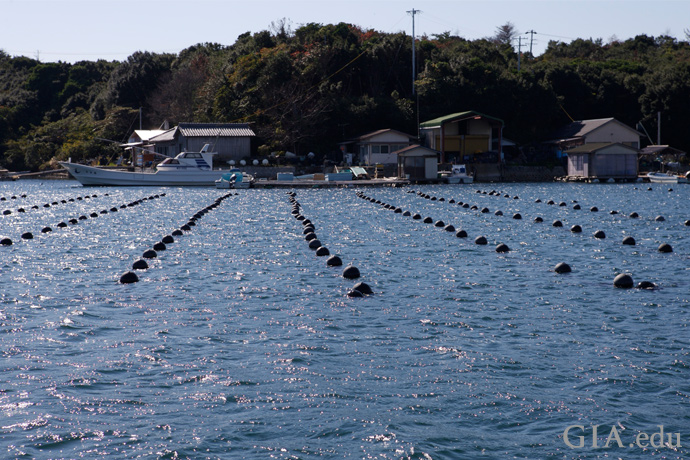
Ago Bay, Japan is one of the most important sites for akoya cultured pearl farms. Photo: Valerie Power/GIA
Freshwater cultured pearls are primarily grown in China, within a 400 mile (644 km) radius of Shanghai.

The breeding waters of a cultured pearl farm in French Polynesia look like a piece of paradise. Photo: Amanda Luke/GIA
Natural pearls have been found in the Arabian Gulf (Persian Gulf) for at least 5,000 years, while divers have been recovering the June birthstone from the Red Sea since 300 BCE. The Strait of Mannar has been providing pearls since 2000 BCE. Starting in the 16th century, during Spanish colonial rule, large quantities of pearls were recovered from the waters off Mexico, Central America and what is now Venezuela. Only small quantities of pearls are found in any of these areas today.
June Birthstone: Pearl Qualities to Look For
As you’re shopping for pearls and comparing quality and prices, keep in mind the seven factors gemologists use to evaluate and describe the quality of the June birthstone. Known as the GIA 7 Pearl Value FactorsTM, they are:
You should also know that cultured pearls routinely undergo treatment to improve their appearance. Some may be color enhanced by heating, dyeing, irradiation and coating. Other treatments include:
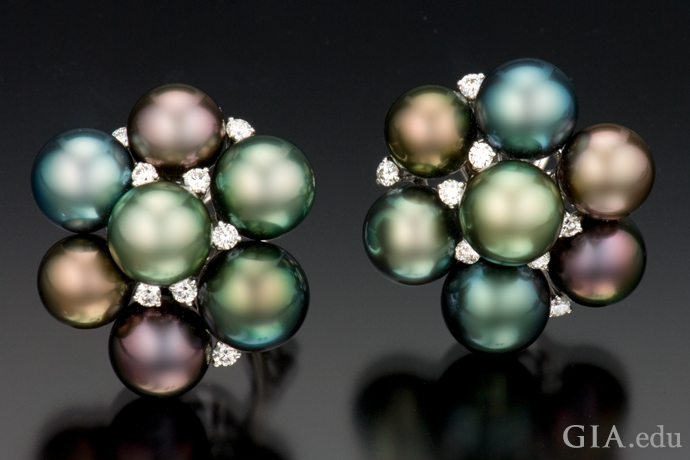
Take special care when cleaning pearl jewelry like these diamond and Tahitian cultured pearl earrings. Photo: Robert Weldon/GIA. Courtesy: Mastoloni, New York
June Birthstone: Pearl Care and Cleaning
Pearls are 2.5 to 3.0 on the Mohs Scale of hardness, so they are a comparatively soft gem and require special care. Store them separately from other gemstones and metal jewelry to prevent scratching. Never store pearls in a plastic bag — plastic can emit a chemical that will damage their surface. Always apply perfume, hair products and cosmetics before putting on your pearl jewelry. The best way to clean your June birthstone: Use a soft, damp cloth, ideally after each time they are worn.
Read more tips on how to care for pearl jewelry to keep your watery treasures beautiful.
June is a month for celebrations, be it weddings, anniversaries, graduations or birthdays. And what better way to celebrate than with the June birthstone. From a classic strand of akoya cultured pearls to a single faceted Tahitian cultured pearl, there’s a look for every taste and budget.
Pearls are trending. Five Easy Pieces shows how to wear them with style.
With spring in full bloom and summer just around the corner, emerald is the perfect choice for the May birthstone. Kings and queens have prized the sought-after green gem for centuries. Here’s how you can pick a breathtaking one.
In this post, we cover:
Gemological Qualities of Emerald
Emerald History & Lore
Where Emerald Comes From
Emerald Qualities to Look For
Emerald Care & Cleaning
May Birthstone: Gemological Qualities of Emerald
Emerald’s green has been the standard by which other green gemstones have been measured for thousands of years. It is the rich green to bluish green variety of beryl, a mineral species that also includes aquamarine and varieties in other colors.
Trace elements that cause emerald’s color include chromium, vanadium and iron. As a general rule, the higher the chromium or vanadium content, the more intense the green color. The more iron present, the greater the degree of blue. When iron content is relatively high, emerald is a bluer green. When iron content is relatively low, the May birthstone is a purer green.
The difference between an emerald and a less-expensive green beryl is a matter of debate among gem experts. Some in the trade describe the May birthstone as any green beryl colored by chromium. However, gemologists, gemological laboratories and most colored stone dealers, think it is incorrect to call a green beryl an emerald when its color is “too light.” There are differences of opinion even in this group about the definition of “too light.” GIA settles the debate by using lab-graded comparison stones to determine if the green color is sufficiently dark and saturated to be called emerald.
Gemologists love the May birthstone for its inclusions. Emeralds from Colombia can have fascinating characteristic inclusions – called three-phase inclusions – that consist of tiny crystals of rock salt, a liquid and a bubble of gas.
The best emerald crystals are also gorgeous flat-topped green hexagonal columns that can rival the beauty of faceted stones.
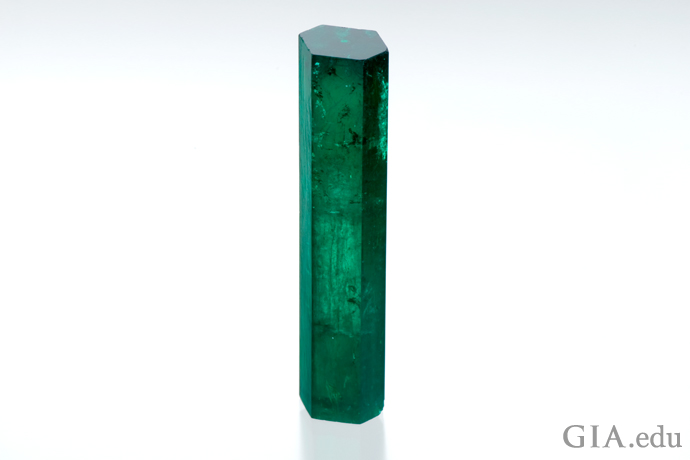
Weighing in at 47 carats, this rough emerald crystal from the Muzo mine in Colombia is so beautiful that it may put to rest all debates about color. Photo: Robert Weldon/GIA. Courtesy: Jon Sigerman
May Birthstone: Emerald History & Lore
From Egyptian pharaohs to Inca emperors, emerald has enchanted royalty. Cleopatra was known to have a passion for emerald, and used it in her royal adornments. The legendary Crown of the Andes, fashioned in colonial South America, is one example of how the Spanish revered the May birthstone. According to lore, its largest stone—now called the Atahualpa emerald—was taken from the last Inca emperor, Atahualpa, by conquistador Francisco Pizarro. The modern recovery of the Spanish galleon Nuestra Señora de Atocha shows the length generations of treasure hunters would go to recover its sunken loot.
The word “emerald” comes from smaragdos, ancient Greek for a green gem. Roman author Pliny the Elder, who died in the 79 CE eruption of Mt. Vesuvius, wrote in his encyclopedic Natural History that “nothing greens greener.” He also stated that the May birthstone had therapeutic properties that helped gem cutters: “(they) have no better method of restoring their eyes than by looking at the emerald, its soft, green color comforting and removing their weariness and lassitude.” Science now proves this belief: The color green relieves stress and eye strain.
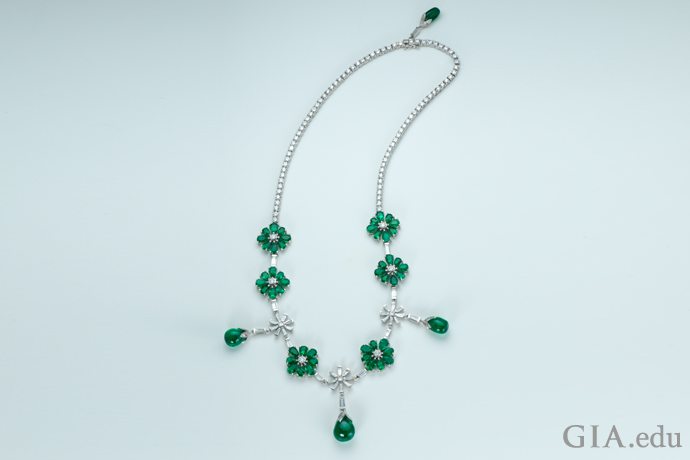
An emerald necklace sure to soothe the eye, this beauty has 52 emeralds, with a total weight of 32.86 carats, and 160 diamonds, with a total weight of 9.11 carats. Photo: Robert Weldon/GIA. Courtesy: Ismael Daoud
Emerald was also thought to have magical powers. By placing it under the tongue, one could see into the future. Some believed the May birthstone offered protection against evil spells, cholera and malaria. Others thought it made one an eloquent speaker and exposed lovers who made false promises.
Emerald is traditionally given for the 20th and 35th wedding anniversaries.
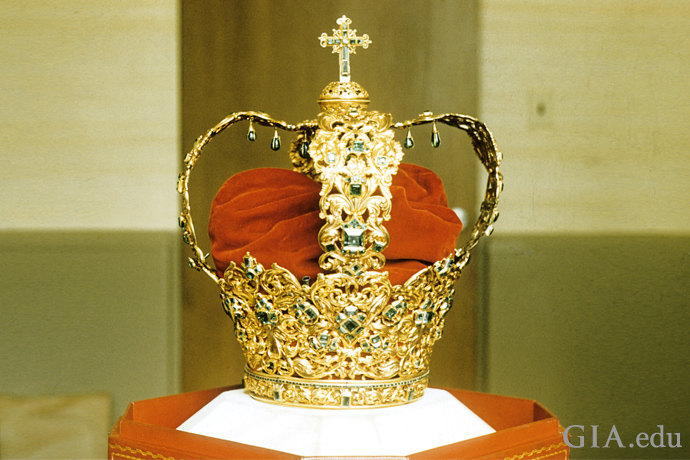
The Crown of the Andes, now at the Metropolitan Museum of Art in New York City, boasts an impressive 24 ct emerald center stone and 442 additional emeralds set in the golden headpiece. Photo: Dr. E. J. Gübelin/GIA
May Birthstone: Where Emerald Comes From
Colombia has been the source of the finest emeralds for more than 500 years, and they have been the standard by which all others are measured. Three mining sites in Colombia are particularly noteworthy: Muzo, Chivor and Coscuez. Emeralds of slightly different hues are found at each of these sites. Each locality produces a range of colors, but generally speaking, darker tones of pure green emeralds come from Muzo. Emeralds that are lighter in tone and slightly bluish green are associated with Chivor. Slightly yellowish green emeralds are unearthed in Coscuez.
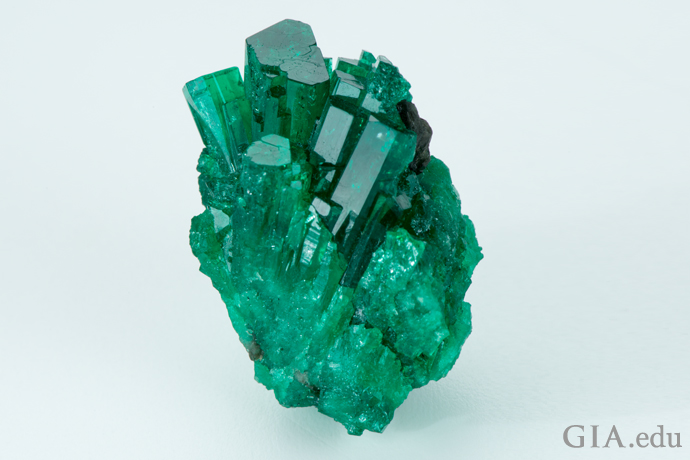
This 38 carat cluster of emerald crystals originated from Colombia’s Muzo Mine. Photo: Robert Weldon/GIA. Courtesy: Ismael Daoud
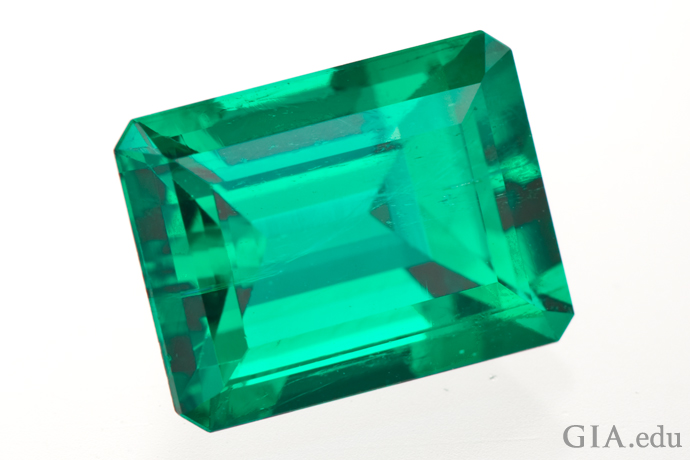
Chivor, Colombia is the source of this 4.50 ct emerald. Photo: Robert Weldon/GIA
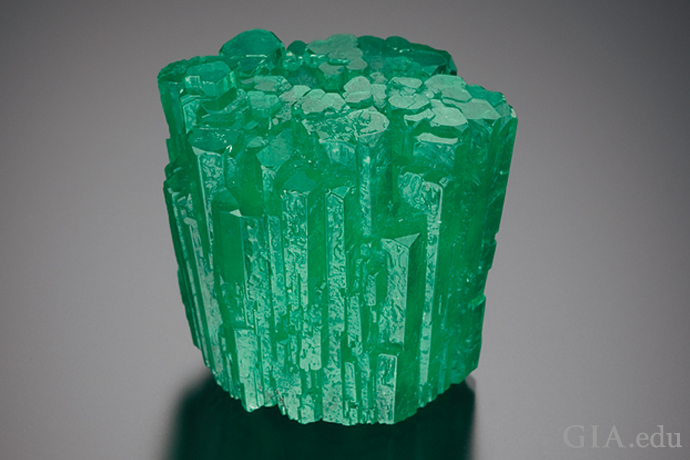
This 88.4 gram emerald crystal cluster is from Coscuez, Colombia. Photo: Robert Weldon/GIA. Courtesy: Gene Meieran
Emeralds are also found in the state of Minas Gerais, Brazil. One of the most productive sites for the May birthstone is the sophisticated Belmont Mine. Capoeirana is another important locality, a rugged region worked largely by independent miners and small-scale operations.
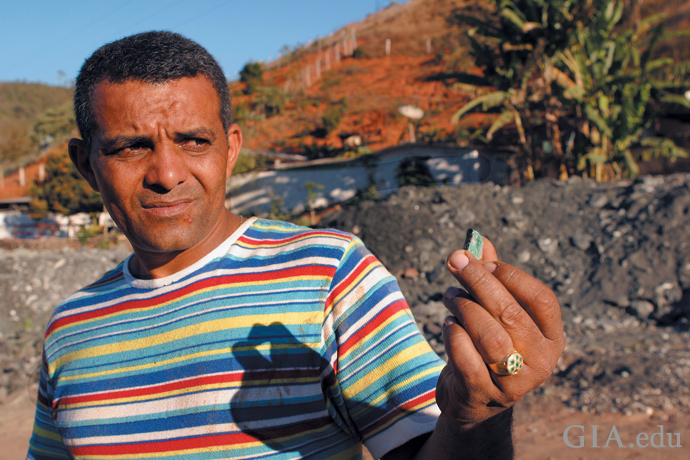
An independent miner at the Capoeirana mining area holds a rough emerald. Photo: Eric Welch/GIA
The May birthstone can also be found in Africa. Zambia is a major source, and mines in the Ndola Rural Restricted Area are known for producing emeralds that are bluish green and darker in tone. Pakistan and Afghanistan are important producers as well.
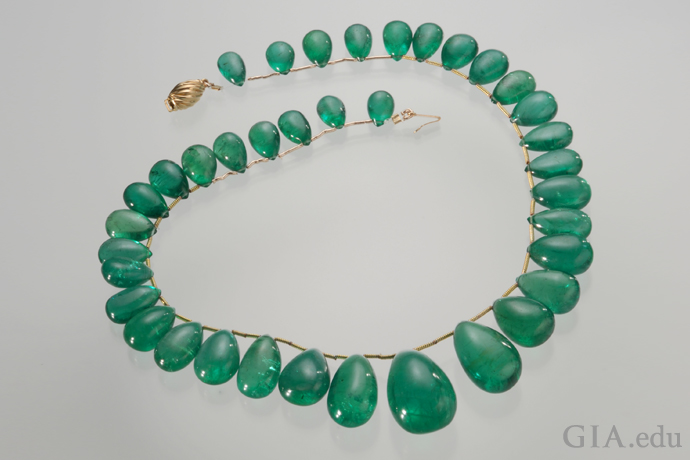
The 240 carats of emeralds in this drop necklace come from Zambia. Photo: Robert Weldon/GIA. Courtesy: Sanjay Chordia, BEACAB GEMS INC.
May Birthstone: Emerald Qualities to Look For
Color: The most important quality factor in the May birthstone is color. Emeralds that are bluish green to green, with strong to vivid saturation and medium to medium-dark tone, are the most coveted. Emeralds that are highly transparent are especially valuable.
Clarity: Emeralds typically contain inclusions that are visible to the unaided eye. Because of this, jewelry professionals and some consumers understand and accept the presence of inclusions in emeralds. Eye-clean emeralds are especially valuable because they’re so rare.
Emerald inclusions are often described as looking mossy or garden-like. They’re sometimes called jardin, which is French for “garden.”
In colored stones, transparency and clarity are closely linked. This is especially true for emeralds. Jewelry professionals generally accept some eye-visible inclusions in higher-quality emeralds. But when the quantity or nature of the inclusions has a negative effect on transparency and clarity, they also dramatically reduce value.
Cut: Emerald crystals are difficult to cut. Almost all rough emeralds have significant fractures (sometimes called fissures) and a gem cutter must work to minimize the effect of those fractures on the appearance of the finished stone.
These inherent fissures make emeralds more brittle than other gems. Consequently, they are vulnerable to damage during cutting, polishing and setting–or even from careless daily wear.
The famous rectangular “emerald cut,” with its beveled corners and two, three or four concentric rows of facets, maximizes the shape and weight of the original emerald crystal. It also helps protect against damage because the vulnerable corners are faceted and provide a comparatively safe place for prongs.
Carat Weight: Fashioned emeralds come in a wide range of sizes. There are emeralds in museums and private collections that weigh hundreds of carats. At the other extreme are tiny emeralds that weigh fractions of a carat.

Take extra caution when caring and cleaning for emerald jewelry like this 3.69 ct emerald ring flanked with six diamond side stones. Photo: Robert Weldon/GIA. Courtesy: Ismael Daoud
May Birthstone: Emerald Care & Cleaning
Emerald is a 7.5 to 8 on the Mohs scale of hardness, so it is more susceptible to scratching than a diamond, which ranks 10 on the scale. The May birthstone is often treated to improve its color and clarity. Common treatment methods include:
Emerald requires some special care; avoid exposure to heat, changes in air pressure (such as in an airline cabin) and harsh chemicals. Never put an emerald in an ultrasonic cleaner. Filled emeralds can also be damaged by exposure to hot water used for washing dishes.
The May birthstone is perfectly suited to the celebration of life blooming everywhere. Now you can treat yourself – or a loved one – to an emerald that captures the exuberance of the season. Learn more about how to pick a beautiful emerald with our Emerald Buying Guide.
Amethyst, the February birthstone, has adorned the nobility for centuries. Now it’s in reach of most consumers. Here’s how to pick a stunning amethyst for the king or queen of your heart – or treat yourself to a royal present.
In this post, we’ll cover:
Gemological Characteristics of Amethyst
Amethyst History & Lore
Where Amethyst Comes From
Amethyst Qualities to Look For
Amethyst Care & Cleaning
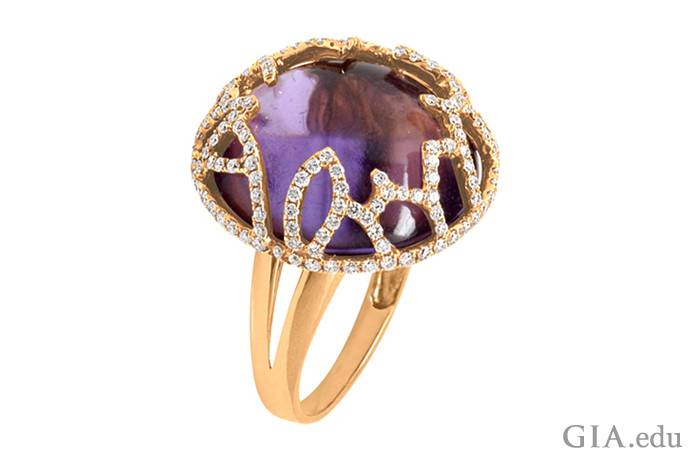
If this ring with an amethyst center stone seems a bit otherworldly, it’s because it comes from the Galaxy collection by Arya Esha. Courtesy: Arya Esha
February Birthstone: Gemological Characteristics of Amethyst
Amethyst is the purple variety of the quartz mineral species. Its color ranges from a strongly saturated violetish purple to reddish purple in fine quality gems; to weak grayish violet in commercial quality stones. Natural irradiation acting on trace amounts of iron in its crystal structure causes amethyst’s characteristic color. Amethyst also commonly shows color zoning, which often occurs as angular bands of darker to lighter purple. The saturated purple color is typically limited to the tips of amethyst crystals, while the rest of the crystal fades to colorlessness. Cutting an amethyst crystal often produces a few high-quality, deep purple stones and many more low-quality, light-colored stones.
Gemologists and consumers alike love amethyst because it is a beautiful gem that is also affordable. Even fine amethyst can have a modest price tag. Here’s another reason: Amethyst rough comes in fascinating packages. In gem localities like Brazil, amethyst sometimes forms in hollow, crystal-lined geodes so big you can stand in them.
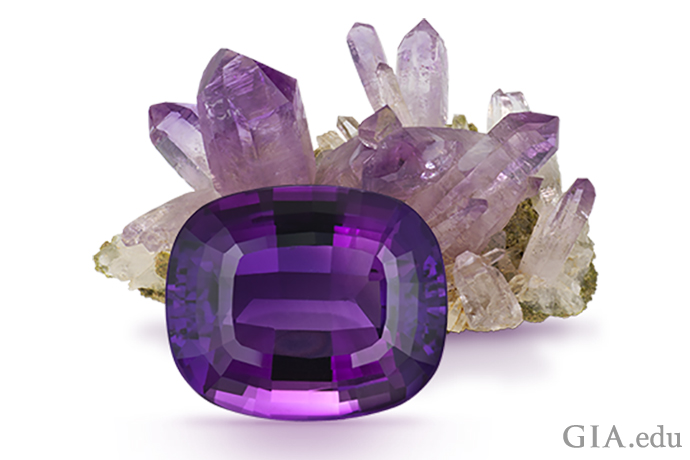
A 22.62 carat (ct) cushion cut amethyst is the dramatic foreground to the amethyst rough behind it. Photo: Robert Weldon/GIA
February Birthstone: Amethyst History & Lore
The name amethyst derives from the Greek amethystos, which means “a remedy against drunkenness,” a benefit long ascribed to the purple gem. It’s no coincidence that methy is the word for wine, typically of a color very similar to that of this gem. Amethyst was also believed to keep the wearer clear headed and quick witted in battle and business affairs. Renaissance Europeans thought it calmed lovers overrun by passion.
Amethyst is the gem traditionally given for the sixth wedding anniversary. Wear it in celebration of your wedding nuptials or as your February birthstone and you’ll be in royal company: Catherine the Great (Empress Catherine II of Russia; 1729–1796) had a penchant for the gem, and decked herself in necklaces, earrings and other amethyst-adorned ornaments. The famous jewelry connoisseur Wallis, Duchess of Windsor (1896–1986) made a memorable statement when she wore a lavish Cartier-designed amethyst bib necklace to a gala in Versailles in 1953.
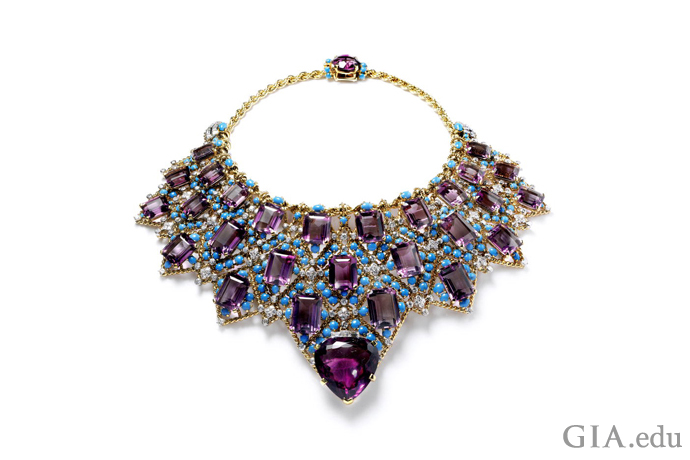
A colorful medley of purple and blue, the Duchess of Windsor’s bib-style necklace boasts 27 step-cut amethysts, one oval faceted amethyst, and a large heart-shaped amethyst in the front, as well as turquoise cabochons and brilliant cut diamonds, all suspended from a rope-like gold chain. Courtesy: N. Welsh, Cartier Collection © Cartier
February Birthstone: Where Amethyst Comes From
Amethyst was as expensive as ruby and emerald until the 19th century, when large deposits were found in Brazil. The country is still an important source for amethyst, and its southernmost state, Rio Grande do Sul, is a particularly productive area. Along with its rich amethyst deposits, the region is also home to vast grassy plains, thick forests, waterfalls, panthers and jaguars.
The Anahí mine in Bolivia is another famous source for amethyst. Hidden in the Pantanál wetlands, the Anahí mine is shrouded in fascinating lore. It was discovered by a Spanish conquistador in the 1600s, given to him as dowry when he married Anahí (a princess from the Ayoreo tribe), forgotten for three centuries, and rediscovered in the 1960s.

A treasure trove of amethyst crystals lines the walls of the Anahí mine. Photo: Robert Weldon/GIA.
The February birthstone is also found in Zambia. The country is a major producer, and the Kariba amethyst mine is an important source. Amethyst mined here tends to be of superb quality with richly saturated colors.
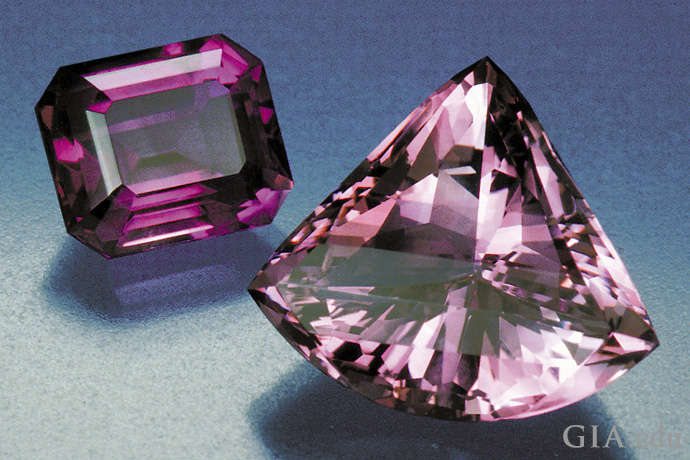
On the left is amethyst from Zambia. On the right is amethyst from Brazil. Photo: Robert Weldon/GIA. Courtesy: Pala International
February Birthstone: Amethyst Qualities to Look For
To pick a stunning gem, consider these tips:

A series of grooves and concave facets breathe movement and life into this striking fantasy cut amethyst pendant. Courtesy: Sonja Kreis Unique Jewellery and Gems
February Birthstone: Amethyst Care & Cleaning
Amethyst is a 7 on the Mohs scale of hardness. This means that it is appropriate for daily use in rings and other jewelry, but over time may show wear and require repolishing. Because amethyst is more susceptible to damage than harder gems such as rubies, sapphires and diamonds, do not store your amethyst jewelry next to these, as they can scratch it.
Heat treatment is the most common technique for improving the color and marketability of natural amethyst. Heat treatment can’t make pale amethyst darker, but it can lighten the color of very dark amethyst and make it more attractive. It can also remove unwanted brownish inclusions in some amethysts. Some amethyst turns yellow–to citrine–with heat treatment.
Heat treating amethyst results in a durable and permanent change in color. However, submitting it to intense heat may render it slightly more brittle than usual, and care must be taken not to damage pointed faceted corners and edges. Note, too, that excessive heat can remove the color entirely, and some amethyst fades with prolonged exposure to strong light. Though the color is stable with normal use, this is not a gem to wear to the beach every day.
Amethyst jewelry can be cleaned with an ultrasonic cleaner or a steamer, but use caution to avoid thermal shock. A soft brush with mild soap is the safest option.
As you shop, you’ll also encounter lab-created amethyst. Having the same chemical properties as its natural counterpart, synthetic amethyst has been manufactured since the 1970s. As manufacturing processes became increasingly sophisticated, it became more difficult for gemological labs to distinguish natural from synthetic amethyst. GIA can tell the difference, but many in the jewelry industry do not request testing because of the expense and time required to determine the origin of what is a comparatively inexpensive gem. Still, merchants are required to tell you if a gem is natural or synthetic.
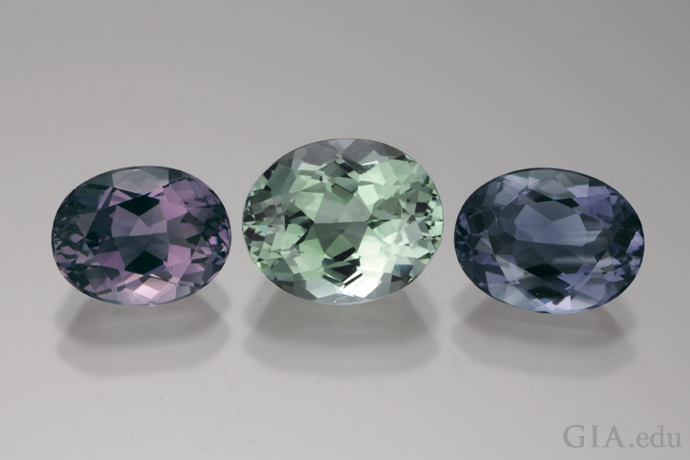
These gems from the Montezuma mine in Minas Gerais, Brazil show the varied coloration of quartz: untreated amethyst (left), heated green quartz (center) and heated and irradiated violet quartz (right). Photo: Robert Weldon/GIA. Gift of Henrique Fernandes and Gabriel Freitas, Pinkstone International, Governador Valadares, Brazil.
Amethyst has enchanted kings and queens for many centuries. Now you know how to buy a royal gift for your love with a February birthday. And for some quick tips, take along our Amethyst Buying Guide the next time you go shopping.
If you were born in December you have a lot to celebrate, including three December birthstones: turquoise, tanzanite and zircon. With a spectrum of colors to choose from, learning about where the sources of these gems will only add to their appeal. (more…)
Born in November? Lucky you! Your November birthstone is not one, but two beautiful gems: One offers a rainbow of colors; the other is famed for its rich yellows. Make choosing easier by learning more about them, including where they come from.
(more…)
Opal’s kaleidoscopic hues have delighted us for centuries. Loved for its spellbinding play-of-color, this October birthstone seems to be a bit magical and mysterious. Get ready to find out where it comes from – and how it forms. (more…)
The world loves rubies! These beautiful gems can command the highest per-carat price of any colored stone and they routinely break auction records. So, let’s find out where the July birthstone comes from! (more…)
When we think of royalty, images of crowns, tiaras, and diadems instantly come to mind. Beautiful head ornaments intricately crafted in gold and encrusted with rare gemstones were once used as symbols of nobility, status, and the right to rule. They dazzled onlookers with their splendor, and even though royal families may have faded in political power, their relics continue to captivate. (more…)
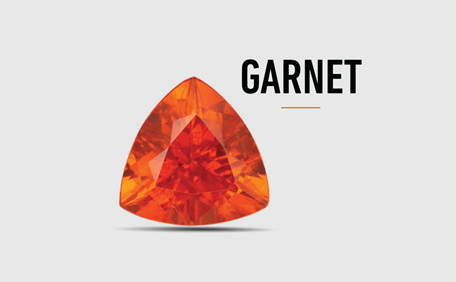
January’s birthstone, garnet, is known for its impressive variety of eye-catching colors, which can be almost any color of the rainbow. Garnets occur in green (demantoid and tsavorite), orange (spessartine), red (almandine and pyrope), and purplish red (rhodolite), plus a few rare garnets even change color under different types of light. But color is far from a garnet’s only attractive feature. (more…)
Those celebrating December birthdays are fortunate to have a few birthstones to choose from – zircon, tanzanite, blue topaz and lapis lazuli, among them. But one of the best known and most loved December gems is turquoise, a gem that has been mined and used for thousands of years. (more…)
As the majority of the country heads into cooler temperatures of late fall/early winter, November’s birthstone, citrine, provides a much needed burst of sunshine. The warm, sunny color of this popular gemstone inspired its name, derived from the French word “citron,” meaning “lemon.” Its color ranges from saturated yellow to reddish orange to pale yellow. (more…)